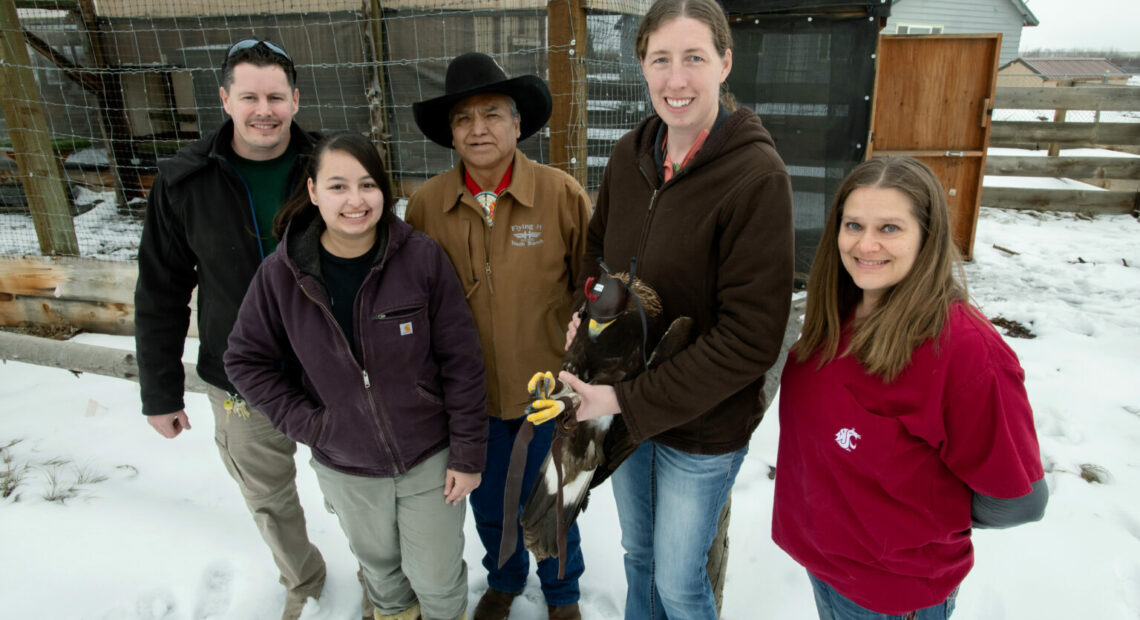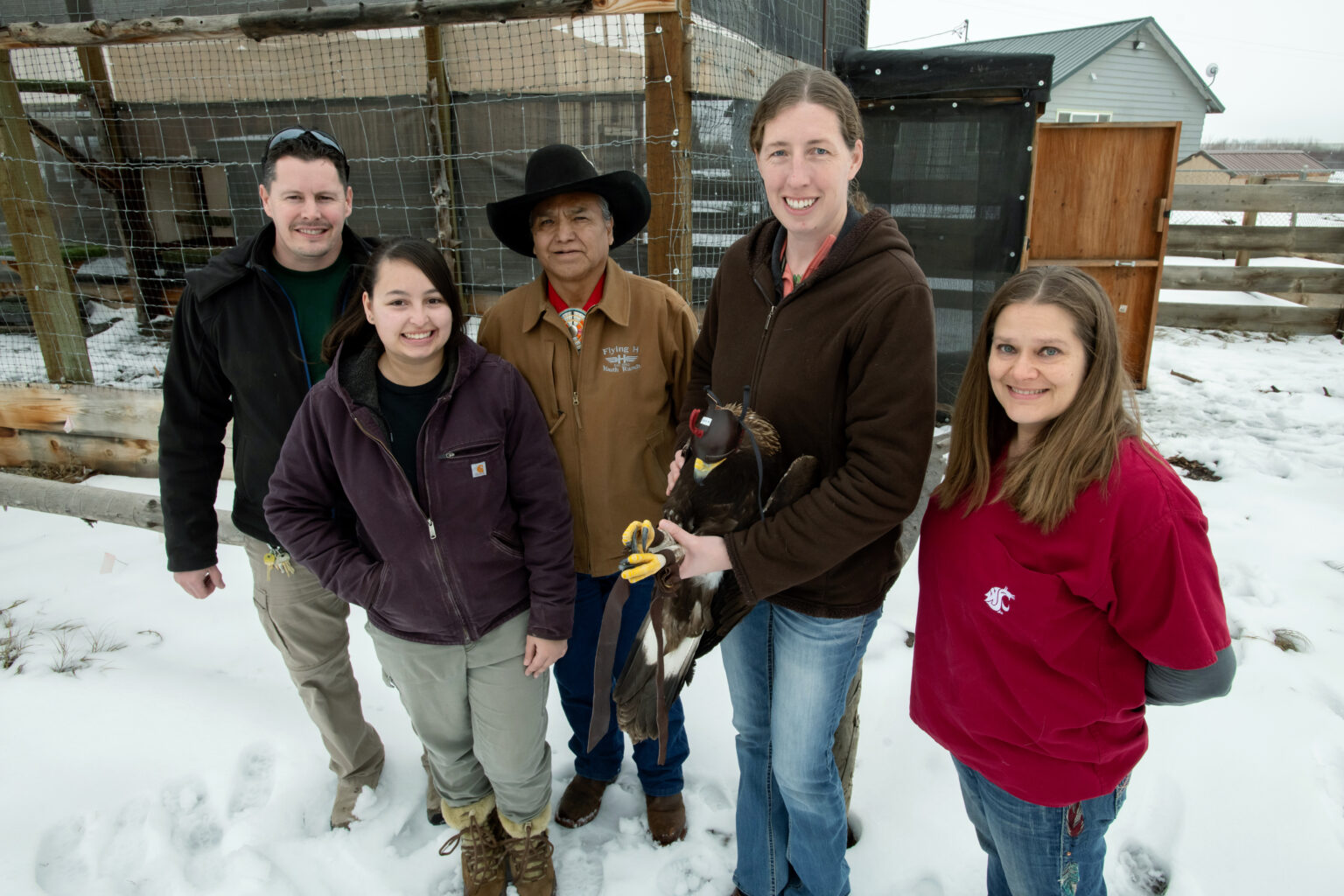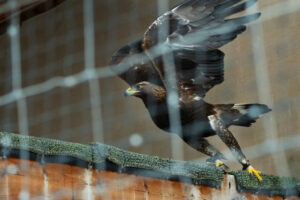
New golden eagle to provide Yakama Nation with sacred ceremonial feathers

Listen
(Runtime 3:46)
Read
Before Jerry Meninick performed a wedding ceremony more than 30 years ago for his daughter and his soon-to-be son-in-law, he told them they needed two center tail feathers from a golden eagle, also called xwayamá in the Sahaptin language of the Columbia Plateau.
Meninick, now the Yakama Nation’s deputy directory, had a special reason for his request.
“When xwayamá hunts way up in the air and he sees his prey move on the ground, he’ll dive over 200 miles per hour. It’s that tail that keeps him from hitting that dirt, hitting the earth,” Meninick said.
In a marriage, he said, pitfalls happen and can come fast. His prayer? That the feathers from this sacred bird would help protect the union. After this long, something worked out right.
“When I offered those feathers, before they were pinned on my daughter, I prayed that during those times when their unity was challenged by whatever reason,” he said, “I prayed to the bird that those feathers do the same for this couple as it does for the bird, bring them back up, rise again with them.”
Now, a young golden eagle recently assigned to the tribe’s aviary will make it easier for tribal members to request feathers for ceremonies. Big life events like graduations, weddings and funerals, where people are laid to rest holding a golden eagle feather. Caretakers will collect feathers when the bird molts once a year.
For the tribe, Meninick said, the golden eagle represents physical and spiritual communication.
“It flies high enough, according to our elders, that it seemingly touches the spiritual side,” Meninick said. “During our prayers, we understand it’s a communication to everything that is here, through its feathers.”

A juvenile golden eagle rehabilitated by Washington State University wildlife veterinarians takes flight, Thursday, Jan. 25, 2024, after being released into an aviary operated by the Confederated Tribes and Bands of the Yakama Nation on the Yakama Indian Reservation in Washington State. (Ted S. Warren, College of Veterinary Medicine, Washington State University)
Each healthy golden eagle, which the tribe considers of higher importance than a bald eagle, carries 36 feathers on each wing. That number comes up time and again in sacred ceremonies, Meninick said, in honor of xwayamá.
Even though it has all its feathers, this golden eagle can’t be released into the wild. Before it came to the aviary, a car likely hit it, said Marcie Logsdon, a wildlife veterinarian at the Washington State University College of Veterinary Medicine.
A good Samaritan brought the bird to WSU last October, where Logsdon discovered a wing fracture and trauma to the bird’s eye.
The wing fracture healed quickly in a splint, the equivalent to breaking a few bones in a person’s hand, but the eye damage appeared permanent, Logsdon said.
“He has partial vision in that eye but not full vision,” she said. “As you can imagine, for a predatory species who has to be able to fly and hunt at the same time, having two good eyes is really important.”
After his injuries healed, veterinarians thought he would be a good fit at the Yakama Nation’s aviary, Logsdon said.
This bird is the third raptor housed at the tribe’s aviary, which includes a red-tailed hawk and a bald eagle. In about five years, the tribe hopes to expand to house around 40 birds of prey, said Michael Beckler, wildlife biologist for the tribe.
Prior to this aviary, the tribe had to request every feather through the National Eagle Repository, based in Colorado, which only fills the requests of federally recognized tribes.
Now, the tribe can distribute feathers without as much bureaucracy, Beckler said.
“We’ve been successful two years in a row, distributing feathers to the graduating class. So, they’ll graduate and they’ll wear it on their hat and they’ll have it for forever,” he said. “The need is high. We just don’t have quite the facility to fulfill all of the need yet.”
In addition to having easier, legal access to feathers, the aviary team plans to train the birds for educational purposes.
“We’re constantly taught that we have to develop that trust bond. We can’t go in and expect these birds to be like, ‘Oh, we’re best friends,’” said Alyssa Woodward, a biologist for the tribe’s aviary. “We’re constantly training with them and building up that relationship.”
Today, Meninick said his daughter stores her two golden eagle feathers in a case hanging in her living room. She still wears them to traditional ceremonies, he said.















